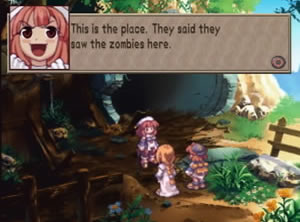The best French tactics since Napoleon.
Tactical strategy RPGs are fairly rare these days, making the release of La
Pucelle: Tactics from little-known publisher Mastiff pretty notable.
And despite looking older than just about any other game for the PS2, this overtly
Japanese take does throw some new ideas into the mix.
In La Pucelle (translation: The Virgin), the story of two novice
Demon Hunters and their teacher plays out through hundreds of intense tactical
battle sequences peppered with several well-orchestrated cut-scenes. Clearly,
then, La
Pucelle qualifies as a turn-based strategy game as well as an RPG. However,
mixed into the battle sequences is a distinct puzzle element, an inclusion which
enhances La Pucelle‘s depth and playability.
La Pucelle‘s dark, melodramatic storyline follows Prier and Culotte, two sassy young agents of La Pucelle, The Church of the Holy Maiden’s demon hunting squad. Given the fact that the Angel Calamity and her minion, The Dark Prince, have been wreaking all sorts of dark havoc and an unleashing all manner of silly-looking demons upon the land, the youngsters of La Pucelle have their work cut out for them.
And so do you, because La Pucelle is neither easy nor fast-paced.
Battles tend to be long and arduous with tough enemies and tons
of potential. Most of La Pucelle‘s strategic elements should be familiar to anyone
who has played Final Fantasy Tactics or La
Pucelle‘s sequel, Disgaea (La
Pucelleactually came out a year prior to Disgaea in Japan).
Battles are viewed from
a 3D isometric perspective, and during each turn the player may move each of
his units as well as have them perform an action.
However, in this case the actual fighting doesn’t take place until the end of
the turn. So you move all your players, tell them to attack this or that and
then end your turn. Then, the battles take place in little classic 2D cut-scenes.
Things get more interesting with Supporting Attacks. If Unit A attacks Unit B,
any friendly units to the right, left or back of Unit A will also be present
in the cut-scene and will attack as well. To complicate the strategy, every
battle area contains Dark Portals, the presence which weakens the La Pucelle
agents. Making matters worse is the fact that every three or four turns a new
enemy will spawn out of a given Dark Portal.
Visually, Dark Portals look like simple, colored diamonds on the floor; energy
corresponding to the portal’s color flows outward from it in one of four directions.
If one of your units stands on one of the portals, they can redirect the flow
of energy. Also, any unit standing on the path of the energy can change its
flow from that point by facing in another direction. If a unit ‘purifies’ a
Dark Portal, any enemy caught in the flow will take damage. Manage to complete
a circuit of dark energy and a Miracle will occur wherein a large God appears
and deals serious damage to any enemy caught within the range of the circuit.
Unfortunately, it’s really hard to maintain a circuit with enemies moving around the map changing flows and your own units dying and whatnot, making it extremely difficult to pull off one of these miracle attacks. Furthermore, defeating enemies via the dark energy itself is a bit counter-productive in that you usually end up taking more damage trying to set up dark energy traps than you would if you simply wiped out the portals and kicked the enemies’ butts.
 However, the Dark Portal system has two saving graces. By continually creating
However, the Dark Portal system has two saving graces. By continually creating
the largest, craziest, multi-source flows you can and then purifying them,
any equipped items gain huge amounts of XP (which means the benefits associated
with those items become stronger). And you can screw around with the Dark Portals forever.
The dynamic creates a persistently changing, combat-oriented puzzle that can
only be solved with a lot of luck and perseverance.
Players can also purify enemy monsters, thereby converting them to the Church’s
cause. Converted monsters join your party, and then can be equipped, leveled
up, and even sold into the dark army (confusing, I know) for nifty items. To
purify a monster, you command a unit (or several) to use the “Purify’ command
on it. Each time a unit purifies, a dialogue box will pop up and tell you how
the enemy feels – for example, “Tiny Bat is considering your offer.” You almost
get the sense your party is preaching to the enemy, like a gang of well-armed
Mormon missionaries. Come to think of it, if I were accosted by a gang of Mormons
wielding fire-staves and gun-blades, I might convert, too.
Even though the combat takes place in a turn-based strategy environment, La
Pucelle is very much an RPG as well. All of your characters and
converted enemies can be leveled up and equipped with new and more powerful
items as the game progresses. Most items are imbued with features and abilities
that become available to a character once the item is equipped. Each of these
abilities gains experience and levels through combat and purifying Dark Portals,
and once an item’s ability reaches a certain level, the item itself can be unequipped
without the character losing the ability. There’s also a fairly complicated elemental
table to take into account, but aside from being somewhat large, it isn’t anything
you haven’t seen before.
 Nor is La Pucelle‘s dated look. The game could definitely be ported to the GBA without taking much of a visual hit. The towns are all in flat 2D, really just backdrops for the limited NPC interactions. Everyone just stands there waiting for you to speak with them. The 3D combat arenas themselves lack any sort of fine visual detail. The “Dark Portals’ are mere 2-D diamonds on the floor, and the characters are usually shaded in a manner that doesn’t match their surroundings. Some Japanese RPG purists might dig it, but I expect a little more out of my PS2.
Nor is La Pucelle‘s dated look. The game could definitely be ported to the GBA without taking much of a visual hit. The towns are all in flat 2D, really just backdrops for the limited NPC interactions. Everyone just stands there waiting for you to speak with them. The 3D combat arenas themselves lack any sort of fine visual detail. The “Dark Portals’ are mere 2-D diamonds on the floor, and the characters are usually shaded in a manner that doesn’t match their surroundings. Some Japanese RPG purists might dig it, but I expect a little more out of my PS2.
La Pucelle‘s music is the same repetitive, upbeat melodies you’ve come to expect form anime-inspired fare. And given the slow pace of battles, the music is a bit inappropriate. Instead, I recommend turning the volume all the way down and putting on some milder background music.
When La Pucelle began and I first met Prier, Culotte and Alouette, all of the dialogue was accompanied by voice-over. I was excited by this because I felt that the voice-over added tangible elements of personality to each character that would have been lost in written dialogue. Unfortunately, it turns out that only the non-interactive cut-scene portions in which important plot details unfold are voiced over. Everything else is in scrolling text. Meh.
La Pucelle is a hard, somewhat lengthy tactical RPG that
gets the job done. However, it’s an older game being published by Mastiff as
though it were new. And even more importantly, Disgaea came
out last year and is more polished than La Pucelle. But if you’re
looking for a cutesy way to while away the hours, or perhaps a gift for your
gamer girlfriend, La Pucelle might just be new enough for you.
-
Interesting strategy elements
-
Odd, funny plot
-
Dark Portal system
-
Really dated graphics
-
Pretty standard gameplay
-
Ubiquitous RPG style











